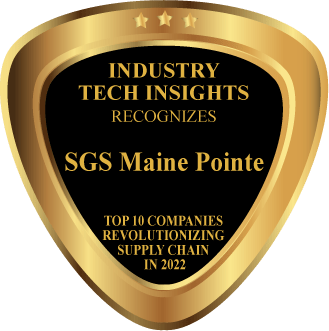
- December 23, 2025 11:51 am
- California

Continued volatility and uncertainty in the end-to-end supply chain have changed the way business leaders calculate improvements to supply ecosystems. The traditional year-over-year incremental improvement has given way to adaptability. Businesses that have thrived are driven by talent, supply chain visibility, and low change barriers. These three drivers enable optionality in the supply chain to mitigate risk and allow companies to seize opportunities. With signs pointing to an upcoming recession, yet another evolution of the supply chain operating model will be required.
Armed with deep industry and consulting experience supporting the CEO agenda for dozens of clients across A&D, industrials, process industries, consumer goods & retail, and private equity, Jeff Staub, CEO of SGS Maine Pointe, states that Covid alone cannot be blamed for the supply chain disruptions. However, Covid has served as a catalyst to expose underlying risk facts, such as the labor shortages leading to an absence of adequate skills, inflation which is a substantial contributing factor, and supply chain shortages and high-friction logistics, all of which inhibit and disrupt productivity.
Jeff notes, “With the challenges of Covid, geo-politics, and more localized impacts such as the Boeing 787 Dreamliner delays, SGS Maine Pointe’s clients are working through how to manage the end-to-end supply chain in a volatile, uncertain, complex, ambiguous (VUCA) world. In the face of those challenges, business expectations don’t stop. As part of this shift, we have added resiliency into our focus on cash, cost, and growth.”
The Challenges and Opportunities of Recession
In an article in Chief Executive in mid-February, while talking to Katie Kuehner-Hebert, Jeff asserted that the unprecedented supply chain challenges that are being witnessed will likely continue through mid-2023. The signs of initial improvement he expected in Q4 2022, despite the conflict between Russia and the Ukraine, now appear unlikely to come to fruition. The looming recession and the continued evolution of consumer demand may accelerate change. The supply chain is simply unable to keep up.
China’s response to the invasion and its zero-Covid strategy may be seen as key indicators on how quickly the global supply chain could find some semblance of normalcy. Even as executives turn to reshoring and seek out regional alternatives to China, the country remains the dominant player in the global supply chain. The Biden administration is also considering reducing tariffs with China, prioritizing a short-term commitment to battle inflation over resetting long-term trade imbalances.
The time needed to get inflation under control is notoriously difficult to predict. The move away from a carbon economy has demotivated investments needed to relieve gas prices; the Ukraine invasion continues to threaten grain and fertilizer shortages, increasing famine risk especially in emerging economies; and investments in chip manufacturing rely on the global supply of neon and palladium from eastern Europe. The labor shortage will continue to be challenging, especially for high fixed-cost operations where asset movement is difficult or impossible. While automation continues to advance, adoption rates haven’t been able to close the productivity gap, with manufacturers struggling to fill over 46 percent of open roles due to a skills mismatch and a reduced labor pool this year. Each of these exacerbates inflation and supply chain challenges.
Jerome Powell, head of Federal Reserve, is “strongly committed” to bringing inflation in check even at the risk of triggering a recession. Although not the type of solution many would have hoped for, a recession coupled with inflation could take the edge off demand, re-engage a portion of workforce, and bring supply chain lead times and pricing stability back in-line with projections, possibly by mid-2023. Certain sectors (grain, fertilizer, and chip manufacturing included) may require 6 to 12 months longer to reach stability.
While it may be impossible to avoid some level of near-term firefighting, the best-positioned companies are creatively exploring all options from band-aid solutions to structurally addressing risk in their supply chain and manufacturing strategies as the landscape continues to rebalance over the next 12 to 18 months.
SGS Maine Pointe’s clients are benefiting from our ability to reduce silos, build dialog and motivation across functions, and improve training and onboarding to ensure a solid return on investment in talent acquisition, development, and thought leadership in the supply chain function. By increasing visibility into the supply chain, we give teams access to real-time and near-real time data and encourage them embed predictive analytics as a core element of their supply chain identity. Establishing clear objectives and the accompanying operating model elements allows the organization to quickly adapt to shifts in metrics, processes, roles and responsibilities; integrate tools; and build capability. This three-pronged approach of adding talent, increasing supply chain visibility, and setting up an operating model for low friction change is the most consistent indicator of success in managing volatility and complexity.
Offering Unique Expertise
SGS Maine Pointe, a member of the SGS Group, is a global supply chain and operations consulting firm trusted by many chief executives and private equity firms to drive compelling economic returns for their companies. SGS Maine Pointe achieves these results by delivering accelerated, sustainable improvements in EBITDA, cash, and growth across procurement, logistics, operations, and data analytics. Their hands-on implementation experts work with executives and their teams to rapidly break through functional silos and transform the plan-buy-make-move-fulfill digital supply chain to deliver the most significant ethical value to customers and stakeholders at the lowest cost to the business. The company calls this Total Value Optimization (TVO)™.
SGS Maine Pointe’s engagements are results-driven and deliver between 4:1-8:1 ROI. “We are so confident in our work and processes that we provide a unique 100% guarantee of engagement fees based on annualized savings,” says Jeff. “SGS Maine Pointe was built on delivering measurable cash, cost, and growth across the end-to-end supply chain.”
Like all firms, the most crucial contribution SGS Maine Pointe can make to their clients is to deliver outstanding work. This inevitably comes down to the teams on the ground. SGS Maine Pointe offers deep SME experience, a broad range of traditional management consultants, and a dedication to partnering with clients to enhance their productivity.
SGS Maine Pointe accelerates outcomes shoulder-to-shoulder with their clients, typically for 4 to 8 months. “We never want to leave the client feeling rushed, they can’t keep up, and all the project resulted in were a few hundred PowerPoint slides,” adds Jeff. “We are client-centric. We are there long enough to pivot with our clients through initiative development, launch, and stabilization without taking the ownership away from our clients. Personally, this is very rewarding because I can identify our impact authentically and see how it shapes our client’s business while still being an agile and strategic partner.”
Towards the Future
One of the largest agriculture and industrial producers in the world turned to SGS Maine Pointe to help them leverage decision support tools, strategically position inventory across the business, and drive cultural and process change to optimize margins and achieve competitive advantage. They needed a digital model of the end-to-end supply chain to understand the causes and solutions for a significant loss in profitability over the preceding year.
SGS Maine Pointe’s SMEs worked closely with the company’s executive team to:
The digital engagement positioned the company to capture tens of millions of dollars of EBITDA improvement.
This is just one of the many exciting client success stories that SGS Maine Pointe has to share. In the days to come, Jeff and his team are focused on forming several partnerships along the digital thread and delivering new digital supply chain projects while working on integrating supply chains and rationalizing networks utilizing digital tools.

" SGS Maine Pointe was built on delivering measurable results in cash, cost, and growth across the end-to-end supply chain. "
Jeff Staub
CEO